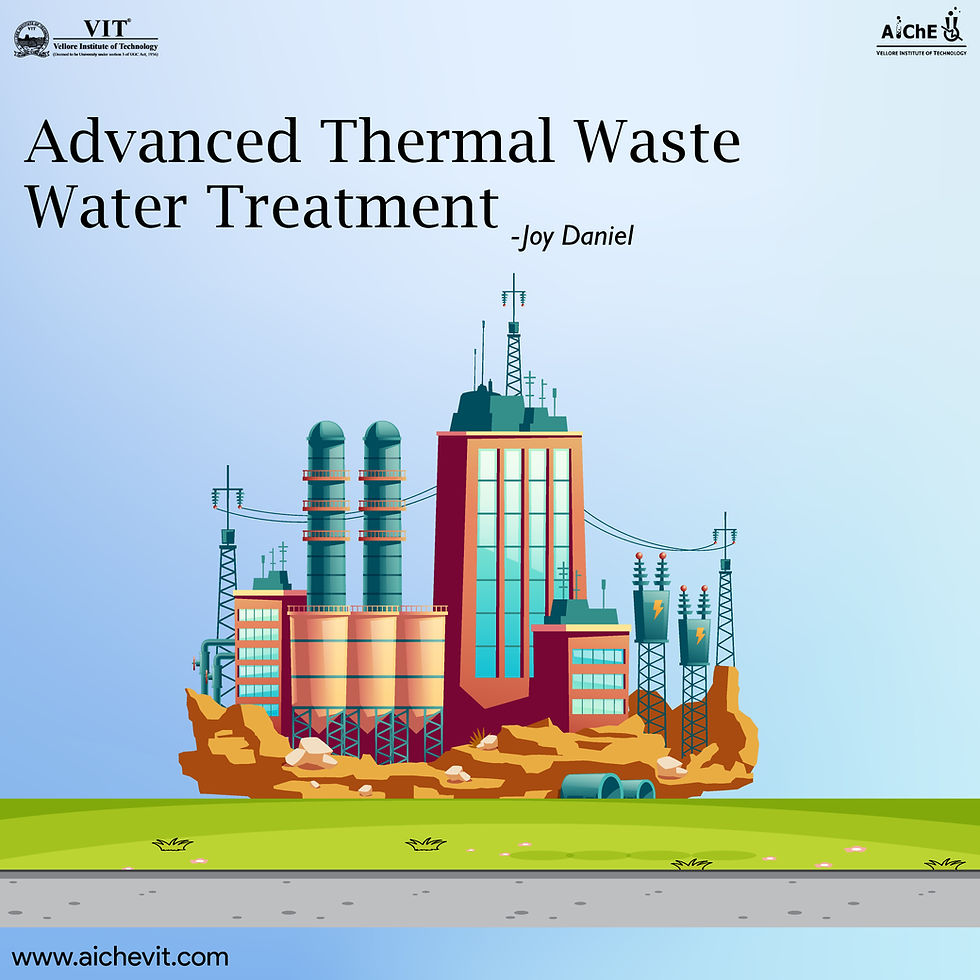OZONE – Nature’s Sunscreen
- AIChE-VIT

- Jun 14, 2022
- 4 min read

Animals and plants could not live on land without a protective ozone layer in the atmosphere. Understanding the processes that govern the ozone concentration of the atmosphere is highly essential before it is too late.
What is the Ozone Layer, exactly?
Despite its name, the Ozone Layer is an area in the lower stratosphere, between 15 and 35 kilometres above the Earth's surface, with a high concentration of Ozone (O3). Approximately 90% of the world's total ozone can be found here. Its thickness fluctuates depending on the season and location. It absorbs biologically hazardous radiation, making it possible to keep life on the planet alive.

Oxygen (O2) and ozone (O3) are naturally balanced in the ozone layer. Ultraviolet light strikes oxygen molecules, splitting them into two oxygen atoms, one of which unites with another oxygen molecule to produce an ozone molecule. Ozone breaks into an oxygen molecule and an oxygen atom under the action of UV radiation. This process is called the 'Ozone – Oxygen Cycle'.

The ozone layer has the ability to block dangerous UV light. At the height of 35 kilometres, all UV-C radiation (280-100 nm) is entirely filtered out. Almost all UV-B light with short wavelengths (315-280 nm) is filtered out completely, while some UV-B radiation with longer wavelengths reaches the surface of the Earth after screening. However, according to research, most UV-A radiation passes through the ozone layer (400- 315 nm). At a wavelength of 290nm, the layer exhibits the highest absorption. UV-A radiation causes genetic damage and skin cancer in people exposed to excessive amounts of the same. Aside from that, radiation can also cause premature skin ageing and bodily harm.
Ozone Depletion Factors
Among the various factors that contribute to ozone depletion, the emission of chlorine and bromine from chemical compounds emitted by industry and other sectors is the most significant. Chlorine or Bromine atoms emitted by Chlorofluorocarbons, also known as CFCs (CFC-11, CFC-12, CFC-13, CFC-114, CFC-115), Halons (Halon 1211, Halon 1301, Halon 2402), Carbon tetrachloride, 1,1,1-trichloroethane, Methyl bromide, Hydrochlorofluorocarbons (HCFCs), and other sources, mix with Ozone molecules to break.

Polar regions, particularly the Southern Pole, suffer from more severe ozone depletion. The Ozone Hole, a dramatic reduction in ozone levels (even less than 220 Dobson Units) above the Antarctic that covered terrain the size of North America, was initially observed in the spring of 1985. Recent studies show that the ozone layer has started to recover, including the Ozone Hole, after the recognition of the hidden threat and successful steps taken to reduce depletion.

Consequences of Ozone Layer Depletion
We would have all perished if the ozone layer had not existed. Ozone depletion has negative consequences for human health as well as other ecosystems. Due to weakened immune systems, exposure to damaging UV radiation may raise the risk of eye illnesses, skin malignancies, and infectious infections.
Ozone depletion has an impact on biogeochemical cycles. It drastically impacts plant matter synthesis and breakdown, primary production and release of critical atmospheric gases, and bacterioplankton development in the upper ocean, among other things. Though the ozone hole has no direct influence on climate change, it can potentially increase the greenhouse effect, leading to climate change and global warming.
What steps are being taken to counteract ozone depletion?
Because of the risks, various international conventions and laws have been enacted to minimise ozone depletion by reducing and eventually eliminating the use and discharge of ODSs. The first worldwide action was held in Washington, D.C. in 1977, with 32 nations participating.
The Montreal Protocol, signed in 1987, is widely regarded as one of the most effective protocols in history. The Vienna Convention for the Protection of the Ozone Layer was founded in 1985 and was the first step toward the Montreal Protocol. According to recent research, human-made chlorine and bromine will be eliminated from the stratosphere by the middle of the twenty-first century, and the ozone layer will be restored to the level it was in the 1980s.
Several additional treaties and laws, such as the Australian Chlorofluorocarbon Management Strategy, the Environmental Protection (Ozone Protection) Policy, and others, are also in place. Furthermore, since 1994, a worldwide day for the protection of the ozone layer (World Ozone Day) has been observed on September 16th to raise community awareness.

As responsible citizens, what can we do?
Protecting the ozone layer is not only the duty of global and government policies and organizations but also of each individual who benefits from its screening process. Refrigerators and air conditioning machines that do not use HCFC as a refrigerant, consumption of aerosol products that do not use HCFCs or CFCs as propellants, proper inspection and maintenance of such machinery to prevent refrigerant leakage, and recycling of refrigerants in vehicle air conditioners are all examples of sensible and responsible citizen behaviour. Aside from personal use, we, as responsible adults, should exercise caution while dealing with ODSs (Ozone Depleting Substances) in the workplace.
It is our most important responsibility to safeguard the ozone layer, not just for the sake of humanity, but also for the benefit of all species on the planet. Let us get in the zone to safeguard ozone starting today, on Earth Ozone Day, and for the rest of our lives as individuals and as a global community working to make the world a better place in the future.
- Abhishek Singh





This is so well written and incredibly detailed! Great work, Abhishek!